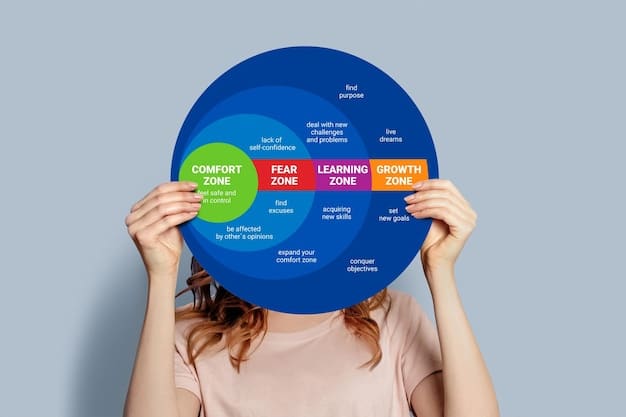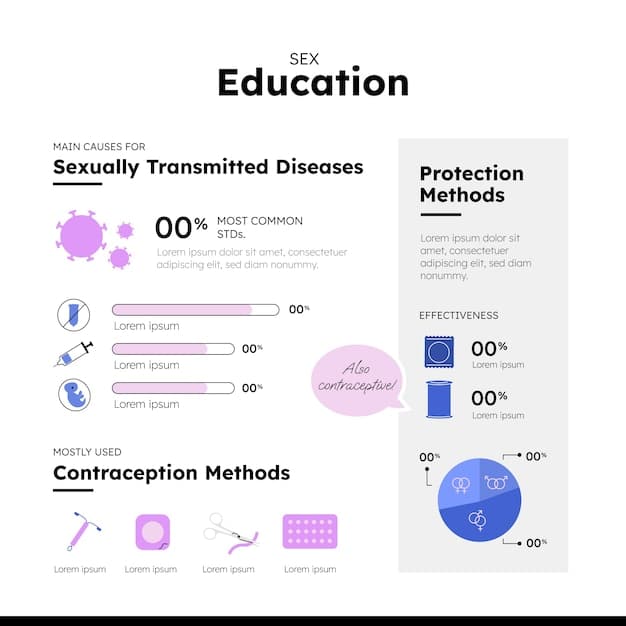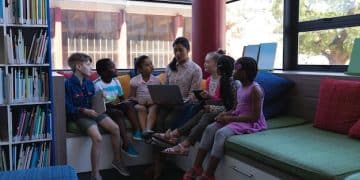The Science of Learning Styles: Myths & Misconceptions in 2025

The science of learning styles has evolved, and in 2025, it’s crucial to debunk common myths and misconceptions surrounding visual, auditory, and kinesthetic learning, embracing evidence-based strategies for effective education.
Do you believe you’re a visual learner or that some people learn better in certain ways? The idea of learning styles is pervasive, but what does the science of learning styles: debunking common myths and misconceptions in 2025 actually say?
Understanding Learning Styles: A 2025 Perspective
The concept of learning styles—the idea that individuals learn best when information is presented in a way that aligns with their preferred style, such as visual, auditory, or kinesthetic—has been a staple in educational discourse for decades. However, as we advance into 2025, it’s essential to re-evaluate these beliefs in light of current research and evidence.
This section will delve into what learning styles are, where the concept originated, and why it has become so popular, despite mounting scientific evidence questioning its validity.
What Are Learning Styles?
Learning styles are traditionally defined as the different ways in which individuals learn most effectively. The most common model, often attributed to Neil Fleming’s VARK model, categorizes learners into visual, auditory, reading/writing, and kinesthetic (VARK) styles.
Each style suggests a preferred method of receiving and processing information. For example, visual learners are thought to benefit from diagrams and charts, while auditory learners thrive with lectures and discussions.
- Visual Learners: Learn best through seeing; prefer diagrams, charts, and demonstrations.
- Auditory Learners: Learn best through listening; prefer lectures, discussions, and audio recordings.
- Reading/Writing Learners: Learn best through written words; prefer notes, reports, articles, and essays.
- Kinesthetic Learners: Learn best through doing; prefer hands-on activities, experiments, and movement.
The appeal of this approach is that educators can tailor their teaching methods to suit each student’s learning style, theoretically enhancing comprehension and retention. However, the scientific basis for this approach is increasingly under scrutiny.
In conclusion, while the concept of learning styles offers an intuitive framework for understanding individual learning preferences, its scientific validity remains highly questionable. Educators and learners alike must approach learning strategies with a critical eye, focusing on evidence-based approaches that promote effective learning for all.
The Rise and Persistence of Learning Styles in Education
Despite the lack of strong scientific evidence, the concept of learning styles persists in educational settings. Understanding why it has remained so popular requires exploring its history, its perceived benefits, and the psychological factors that contribute to its enduring appeal.
This section delves into the reasons behind the widespread adoption of learning styles, while also examining the potential drawbacks of relying on this unproven theory.
Historical Context
The idea of catering to individual learning differences dates back to the early 20th century. Educators and psychologists sought ways to personalize instruction and improve student outcomes. The concept of learning styles gained traction in the 1970s and 1980s, driven by the belief that tailoring instruction to individual preferences could enhance learning outcomes.
Numerous models and frameworks emerged, each proposing different categories and characteristics of learning styles. This proliferation of models contributed to the widespread acceptance of the concept, but also led to confusion and inconsistencies in its application.

Psychological Appeal
The popularity of learning styles can be attributed to several psychological factors. Firstly, it offers a simple and intuitive explanation for differences in learning outcomes. It suggests that if a student is struggling, it may be due to a mismatch between their learning style and the teaching method.
Secondly, the concept aligns with the broader trend of personalized learning. Educators and parents are increasingly interested in tailoring education to meet the unique needs and preferences of each child.
- Confirmation Bias: People tend to seek out and interpret information that confirms their existing beliefs.
- Placebo Effect: The belief that a particular approach will be effective can actually lead to improved outcomes, regardless of its actual efficacy.
- Barnum Effect: Individuals tend to accept generalized personality descriptions as uniquely applicable to themselves.
In summary, the persistence of learning styles in education can be attributed to a combination of historical context, psychological appeal, and the desire for personalized instruction. However, it’s crucial to acknowledge that these factors do not validate the scientific basis of learning styles.
The Scientific Critique: What the Research Says
While learning styles remain popular, a growing body of research challenges their validity. Studies have consistently failed to find evidence that matching instruction to an individual’s preferred learning style leads to improved learning outcomes. This section will explore the scientific critique of learning styles, examining the empirical evidence that questions their effectiveness and the reasons why they may not hold up under scrutiny.
Understanding the limitations of learning styles is crucial for educators and learners alike. It enables a shift toward evidence-based strategies that promote effective learning for all students, regardless of their perceived learning style.
Lack of Empirical Evidence
One of the main criticisms of learning styles is the lack of empirical evidence supporting their effectiveness. Numerous studies have investigated whether matching instruction to an individual’s preferred learning style leads to improved learning outcomes.
A comprehensive review of the literature by Pashler et al. (2008) concluded that there is no solid evidence to support the idea that learning is enhanced when instruction is matched to learning styles. The authors argued that many studies claiming to support learning styles suffer from methodological flaws, such as failing to assess whether students actually learn better when taught in their preferred style.
Alternative Explanations
Instead of attributing learning differences to learning styles, researchers have pointed to other factors that play a more significant role in academic success. These include prior knowledge, motivation, cognitive abilities, and effective study strategies.
For example, students with strong prior knowledge in a subject are likely to learn new information more easily, regardless of the teaching method used. Similarly, highly motivated students are more likely to engage with the material and persist through challenges.
- Cognitive Abilities: General intellectual ability, working memory capacity, and attention span significantly impact learning outcomes.
- Motivation: A student’s intrinsic motivation and interest in the subject matter strongly influence their engagement and learning.
- Effective Study Strategies: The use of evidence-based study techniques, such as spaced repetition and retrieval practice, can enhance learning outcomes more effectively than catering to learning styles.
In conclusion, the scientific critique of learning styles is based on a lack of empirical evidence and the identification of alternative factors that better explain learning differences. Educators and learners should focus on evidence-based strategies that promote effective learning for all, rather than relying on the unproven concept of learning styles.
Effective Learning Strategies: Beyond Learning Styles
If learning styles are not the key to effective education, what strategies should educators and learners focus on? A wealth of research has identified several evidence-based approaches that promote meaningful learning and long-term retention. This section will explore some of these strategies, emphasizing their effectiveness across different learning contexts and individual differences.
By shifting the focus from learning styles to effective learning strategies, educators can create more inclusive and impactful learning environments that benefit all students.
Active Recall
Active recall, also known as retrieval practice, involves actively retrieving information from memory rather than passively rereading or reviewing material. This strategy strengthens memory traces and promotes long-term retention.
Techniques such as self-testing, flashcards, and practice questions can be used to promote active recall. The act of retrieving information forces the brain to work harder, leading to deeper processing and better retention.
Spaced Repetition
Spaced repetition involves reviewing material at increasing intervals over time. This strategy takes advantage of the forgetting curve, the phenomenon that describes how information is gradually forgotten over time.
By revisiting material just before it is forgotten, spaced repetition strengthens memory traces and prevents information from fading. This technique is particularly effective for learning large amounts of information over an extended period.

Interleaving
Interleaving involves mixing different topics or types of problems during study sessions. This strategy forces the learner to discriminate between different concepts and apply the appropriate solution.
Rather than studying one topic in isolation, interleaving encourages the learner to switch between different topics, promoting deeper understanding and better problem-solving skills.
In summary, effective learning strategies such as active recall, spaced repetition, and interleaving have been shown to promote meaningful learning and long-term retention. By focusing on these evidence-based approaches, educators and learners can move beyond the limitations of learning styles and create more impactful learning experiences.
Implications for Educators: Creating Inclusive Environments
For educators, understanding the limitations of learning styles has significant implications for instructional design and classroom practices. It calls for a shift away from tailoring instruction to individual learning styles and toward creating inclusive learning environments that support the diverse needs of all students.
This section will explore practical strategies for educators to create inclusive classrooms that promote effective learning for all students, regardless of their perceived learning style.
Universal Design for Learning (UDL)
Universal Design for Learning (UDL) is a framework that guides the design of instructional materials and activities to be accessible and engaging for all learners. UDL emphasizes providing multiple means of representation, action and expression, and engagement.
By incorporating UDL principles into their teaching, educators can create flexible and adaptable learning environments that meet the diverse needs of all students.
Varied Instructional Strategies
Rather than focusing on catering to specific learning styles, educators should employ a variety of instructional strategies that engage different cognitive processes and learning preferences. This could include lectures, discussions, hands-on activities, visual aids, and written assignments.
By incorporating a range of instructional methods, educators can provide opportunities for all students to connect with the material in meaningful ways.
- Collaborative Learning: Group projects, peer teaching, and discussions promote active engagement and deeper understanding.
- Technology Integration: Incorporating technology tools, such as simulations, videos, and interactive software, can enhance engagement and provide alternative means of representation.
- Real-World Connections: Connecting learning to real-world contexts and applications can increase relevance and motivation.
In conclusion, educators can create inclusive learning environments by embracing UDL principles and employing a variety of instructional strategies. By focusing on effective teaching practices that support the diverse needs of all students, educators can promote meaningful learning and academic success, regardless of their perceived learning style.
Looking Ahead: The Future of Learning and Education in 2025
As we move further into 2025, the future of learning and education is likely to be shaped by advances in technology, a deeper understanding of cognitive science, and a growing emphasis on personalized learning. This section will explore some of the key trends and developments that are likely to impact education in the coming years, with a focus on evidence-based practices and innovative approaches.
By staying informed and embracing new ideas, educators and learners can adapt to the changing landscape of education and create more effective and engaging learning experiences.
Personalized Learning
Personalized learning is an approach to education that tailors instruction to meet the individual needs and preferences of each student. However, unlike learning styles, personalized learning is based on evidence-based practices and data-driven decision-making.
Technology tools, such as adaptive learning platforms, can be used to assess student knowledge and skills, provide individualized instruction, and track progress over time.
Artificial Intelligence (AI)
Artificial intelligence (AI) has the potential to transform education in several ways. AI-powered tutoring systems can provide personalized feedback and support to students, while AI-driven assessment tools can automate grading and provide insights into student learning.
AI can also be used to create more engaging and interactive learning experiences, such as virtual reality simulations and educational games.
- Data Analytics: Analyzing student data to identify patterns and trends that can inform instructional decisions.
- Adaptive Assessments: Using technology to adjust the difficulty of assessments based on student performance.
- Virtual and Augmented Reality: Creating immersive learning experiences that can enhance engagement and understanding.
In summary, the future of learning and education in 2025 is likely to be shaped by personalized learning, artificial intelligence, and a growing emphasis on evidence-based practices. By embracing these trends and innovations, educators and learners can create more effective and engaging learning experiences that prepare students for success in the 21st century.
| Key Concept | Brief Description |
|---|---|
| 💡 Learning Styles | Belief that individuals learn best through specific methods like visual or auditory. |
| 🔬 Scientific Critique | Research lacks solid evidence supporting enhanced learning via matched instruction. |
| 🧠 Effective Strategies | Active recall, spaced repetition, and interleaving are evidence-based approaches. |
| 🧑🏫 Inclusive Education | Universal Design for Learning (UDL) and varied strategies support diverse learners. |
FAQ
▼
Despite their popularity, scientific evidence does not support the idea that tailoring instruction to learning styles improves learning outcomes. It’s better to focus on evidence-based strategies.
▼
Effective strategies include active recall, spaced repetition, and interleaving. These methods promote deeper understanding and long-term retention, regardless of perceived learning styles.
▼
Educators can use Universal Design for Learning (UDL) principles and varied instructional strategies to accommodate diverse learning needs. This approach supports all students effectively.
▼
Technology like AI-powered tutoring systems and adaptive learning platforms can personalize education. Data analytics and virtual reality also enhance learning experiences effectively.
▼
Focus on cognitive abilities, motivation, prior knowledge, and effective study strategies. These factors have a more significant impact on learning outcomes than catering to learning styles.
Conclusion
In conclusion, while the concept of learning styles has been a popular framework for understanding individual learning preferences, the scientific evidence does not support its effectiveness. As we move into 2025, it’s crucial to shift the focus toward evidence-based strategies and inclusive teaching practices that promote meaningful learning for all students, regardless of their perceived learning style.





